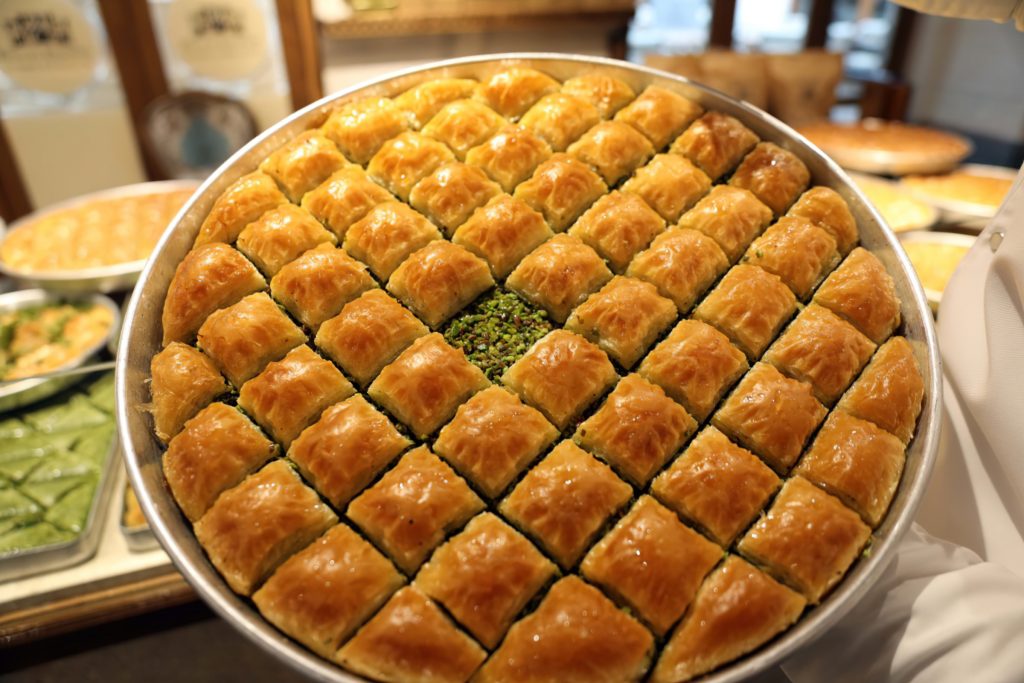Let’s embark on a culinary journey into the heart of Middle Eastern desserts, starting with the iconic Baklava. Originating from the Ottoman Empire, this layered pastry dessert is a delicious combination of finely chopped nuts, sweet syrup, and crispy filo pastry.
Ingredients:
- Filo pastry sheets
- Unsalted butter
- A mix of chopped nuts (walnuts, pistachios, and almonds)
- Sugar
- Water
- Honey
- Ground cinnamon
- Lemon juice
Method:
- Preheat your oven to 180°C. Melt the butter in a pan and keep it warm.
- Combine the nuts, sugar, and cinnamon. Brush the baking dish with melted butter and lay a sheet of filo at the bottom. Brush the sheet with butter and repeat the process until you have layered about ten sheets.
- Spread the nut mixture evenly over the filo. Layer another ten sheets of filo, brushing each with butter.
- Cut the layered pastry into diamond shapes using a sharp knife. Bake for 50 minutes, or until golden brown.
- While the baklava is baking, prepare the syrup. Combine sugar, water, honey, and lemon juice in a saucepan. Bring to a boil, then reduce heat and simmer for about 10 minutes.
- Once the baklava is cooked, remove from the oven and immediately pour the syrup over it. Let it cool completely before serving.
Decadent Dates: A Taste of the Oasis
Another prominent dessert in the Middle Eastern culinary universe is dates. These sweet, sticky fruits are often stuffed with nuts and coated in syrup to create a simple yet delicious dessert.
Ingredients:
- Medjool dates
- Almonds
- Orange blossom water
- Sugar
Method:
- Start by pitting the dates and replacing the pit with an almond.
- Dip each date in orange blossom water and then roll it in sugar.
- Arrange the dates on a platter and serve.
These recipes offer a glimpse into the irresistible world of Middle Eastern desserts. They are sweet, flavorful, and rich, embodying the essence of Middle Eastern hospitality and generosity. Enjoy this sweet journey and explore more recipes to expand your culinary horizons.
Maamoul: The Holiday Cookie
For many in the Middle East, no holiday is complete without Maamoul. These shortbread cookies filled with dates, pistachios, or walnuts are an enduring symbol of celebration and festivity.
Ingredients:
- Semolina
- All-purpose flour
- Melted ghee
- Sugar
- Instant yeast
- Milk
- Filling of your choice (dates, walnuts, or pistachios)
- Powdered sugar for dusting
Method:
- Mix the semolina, flour, and sugar in a large bowl. Add the ghee and mix until the dough takes on a sandy texture.
- Dissolve the yeast in warm milk and add it to the dough. Knead until it becomes smooth and soft.
- Cover the dough and let it rest for about 2 hours.
- Prepare your chosen filling – dates should be pitted and mashed, while nuts should be finely chopped and mixed with sugar.
- Divide the dough and the filling into equal parts. Stuff each portion of dough with the filling and shape it into a ball. You can use a maamoul mold to give them their distinctive shape.
- Arrange the cookies on a baking sheet and bake at 200°C for 15 minutes or until golden. Once cooled, dust with powdered sugar before serving.
Kunafa: The Queen of Arabic Desserts
No exploration of Middle Eastern desserts would be complete without mentioning Kunafa. This cheesy, syrupy dessert has captured hearts across the globe with its unique taste and texture.
Ingredients:
- Kataifi shredded pastry
- Melted unsalted butter
- Sweet cheese or mozzarella
- Sugar
- Water
- Lemon juice
- Rose water
- Ground pistachios for garnish
Method:
- Begin by tearing the kataifi pastry into small pieces and mixing it with melted butter.
- Press half of the mixture into a baking dish, followed by a layer of cheese. Cover with the remaining kataifi, pressing it down firmly.
- Bake at 180°C for about 30 minutes or until golden.
- While the kunafa is baking, prepare the syrup. Combine sugar, water, lemon juice, and rose water in a saucepan. Bring to a boil, then reduce heat and simmer for about 10 minutes.
- Once the kunafa is ready, pour the syrup over it while it’s still hot. Let it cool for a bit before flipping it onto a serving platter. Garnish with ground pistachios and serve.
These recipes provide a sweet ending to any meal, embodying the warmth and richness that is characteristic of Middle Eastern cuisine. Their allure lies not just in their taste, but in their ability to bring people together, making every bite a celebration of culture and tradition.

